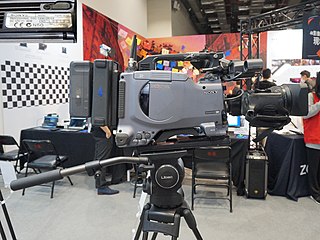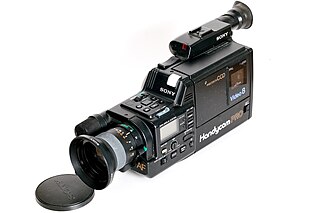Related Research Articles

Digital video is an electronic representation of moving visual images (video) in the form of encoded digital data. This is in contrast to analog video, which represents moving visual images in the form of analog signals. Digital video comprises a series of digital images displayed in rapid succession, usually at 24, 25, 30, or 60 frames per second. Digital video has many advantages such as easy copying, multicasting, sharing and storage.

DV is a family of codecs and tape formats used for storing digital video, launched in 1995 by a consortium of video camera manufacturers led by Sony and Panasonic. It includes the recording or cassette formats DV, MiniDV, DVCAM, Digital8, HDV, DVCPro, DVCPro50 and DVCProHD. DV has been used primarily for video recording with camcorders in the amateur and professional sectors.

Videotape is magnetic tape used for storing video and usually sound in addition. Information stored can be in the form of either an analog or digital signal. Videotape is used in both video tape recorders (VTRs) and, more commonly, videocassette recorders (VCRs) and camcorders. Videotapes have also been used for storing scientific or medical data, such as the data produced by an electrocardiogram.

Digital8 is a consumer digital recording videocassette for camcorders developed by Sony, and introduced in 1999. It is technically identical to DV cassettes, but uses physical Hi8 tapes instead.

D-1 or 4:2:2 Component Digital is an SMPTE digital recording video standard, introduced in 1986 through efforts by SMPTE engineering committees. It started as a Sony and Bosch – BTS product and was the first major professional digital video format. SMPTE standardized the format within ITU-R 601, also known as Rec. 601, which was derived from SMPTE 125M and EBU 3246-E standards.

A camcorder is a self-contained portable electronic device with video and recording as its primary function. It is typically equipped with an articulating screen mounted on the left side, a belt to facilitate holding on the right side, hot-swappable battery facing towards the user, hot-swappable recording media, and an internally contained quiet optical zoom lens.

The 8mm video format refers informally to three related videocassette formats. These are the original Video8 format and its improved successor Hi8, as well as a more recent digital recording format known as Digital8. Their user base consisted mainly of amateur camcorder users, although they also saw important use in the professional television production field.

MicroMV is a proprietary videotape format introduced in October 2001 by Sony. It is the smallest videotape format — 70% smaller than MiniDV or about the size of two US quarter coins; it is also smaller than a Digital8 or DV cassette and slightly smaller than an audio microcassette. It was the first helical scan tape system using MR read head introduced to the market. Each cassette can hold up to 60 minutes of video.

HDV is a format for recording of high-definition video on DV videocassette tape. The format was originally developed by JVC and supported by Sony, Canon, and Sharp. The four companies formed the HDV Consortium in September 2003.

Handycam is a line of camcorders made by Sony and introduced in 1985.

XDCAM is a series of products for digital recording using random access solid-state memory media, introduced by Sony in 2003. Four different product lines – the XDCAM SD, XDCAM HD, XDCAM EX and XDCAM HD422 – differ in types of encoder used, frame size, container type and in recording media.
Progressive segmented Frame is a scheme designed to acquire, store, modify, and distribute progressive scan video using interlaced equipment.

Digital cinematography is the process of capturing (recording) a motion picture using digital image sensors rather than through film stock. As digital technology has improved in recent years, this practice has become dominant. Since the 2000s, most movies across the world are captured as well as distributed digitally.

Sony HDVS is a range of high-definition video equipment developed in the 1980s to support an early analog high-definition television system thought to be the broadcast television systems that would be in use today. The line included professional video cameras, video monitors and linear video editing systems.

A three-CCD (3CCD) camera is a camera whose imaging system uses three separate charge-coupled devices (CCDs), each one receiving filtered red, green, or blue color ranges. Light coming in from the lens is split by a beam-splitter prism into three beams, which are then filtered to produce colored light in three color ranges or "bands". The system is employed by high quality still cameras, telecine systems, professional video cameras and some prosumer video cameras.

Sony CCD-VX3 is a Hi-8 camcorder noteworthy for being the first handheld camcorder to feature trichroic imaging. It was released to the North American market in 1992 at a street cost of about US$3500.

Sony Corporation produces professional, consumer, and prosumer camcorders such as studio and broadcast, digital cinema cameras, camcorders, pan-tilt-zoom and remote cameras.

The Sony DCR-TRV900 was a DV tape camcorder released by Sony in 1998, with an MSRP of USD $2699. It was intended as a high-end consumer camera, more portable and less expensive than the top-of-the-line DCR-VX1000. In 2002, Sony replaced the TRV900 with the somewhat less well-received DCR-TRV950.
XAVC is a recording format that was introduced by Sony on October 30, 2012. XAVC is a format that will be licensed to companies that want to make XAVC products.
References
- ↑ "The Consumer Electronics Hall of Fame: Sony DCR-VX1000 - IEEE Spectrum". IEEE Spectrum: Technology, Engineering, and Science News. Retrieved 27 June 2021.
- ↑ "The History of Skateboarding's Favorite Camera". YouTube . Jenkem Magazine. Sep 21, 2020.
- ↑ "VX1000: The Story of Skateboarding's Most Iconic Camera". YouTube . Red Bull Skateboarding. June 15, 2023. Retrieved July 23, 2023.
- ↑ "How Sony unintentionally defined the skate video". engadget.com. Engadget. 30 September 2022. Retrieved 23 July 2023.
- ↑ Hurbis-Cherrier, Mick (13 March 2007). Voice and Vision: A Creative Approach to Narrative Film and DV Production - Google Books. CRC Press. ISBN 978-1-136-06790-7 . Retrieved 22 November 2023.
- ↑ Jackman, John (6 August 2012). Lighting for Digital Video and Television - Google Books. CRC Press. ISBN 978-1-136-05718-2 . Retrieved 22 November 2023.
- ↑ Evans, Russell (31 July 2013). Practical DV Filmmaking - Google Books. CRC Press. ISBN 978-1-136-06798-3 . Retrieved 22 November 2023.
- ↑ DVCAM - Google Books. Taylor & Francis. 22 August 2013. ISBN 978-1-136-04762-6 . Retrieved 22 November 2023.
- ↑ Smith, Steve. "From Film to DV".
- ↑ "Dom Joly: how we made Trigger Happy TV". the Guardian. 2020-02-24. Retrieved 2021-11-28.